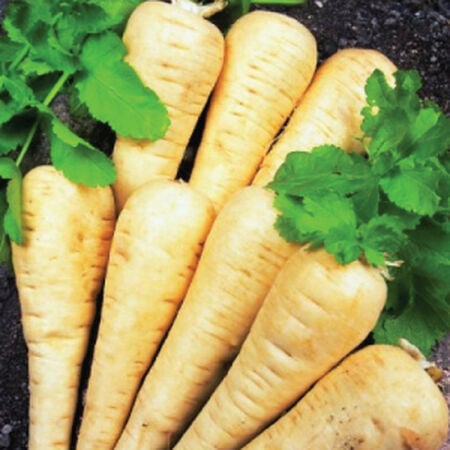Hollow Crown, Parsnip Seeds
Key Attributes
Key Attributes
Product Details
Weight
0.015Depth
0.2Height
4.5Width
3.25Botanical Name
Pastinaca sativaSeed Type
SeedSeeds Per Gram
243Seeds Per Pound
110,000Row Spacing
12-18"Packet
500 SeedsSow Depth
1/2"Seeds Per Ounce
6,875Breed
Open-pollinatedSun
Full SunGrowing Conditions
OverwinteringLife Cycle
AnnualSeed Count
Approximately 120,000 seeds per pound (7,500 seeds per ounce).Sow Method
Direct SowPlant Spacing
1"Categories
ParsnipGermination
7,8,9,10Days To Maturity (# Days)
105Heirloom
HierloomSeeds Per Acre
4 lbsComponents
Growing Instructions
![]() Learning Download: How to Grow Parsnips
Learning Download: How to Grow Parsnips
Parsnips are a root vegetable that look similar to a carrot, though they are paler in color and have a stronger taste. Parsnips have a long growing season and should be planted as soon as the soil can be worked.
Before Planting: Parsnips love deep, loose and fertile soils, with a pH range of 6-7.0. Adding sand or peat moss to your soils before parsnips are planted is recommended for best results.
Planting: Sow in early to middle spring, 1″ apart, 1/2″ deep, in rows 18-24″ apart. Parsnip seeds are slow to germinate in cold soil and may take 2-4 weeks. Do not allow soil to dry out prior to emergence. Thin plants to 2-3″ apart. Parsnips also can be started inside, where you can mix the seeds with compost in a bag and then tie off the bag. Leave the bag in a warm, dark place and seedlings should sprout within a week. After they’ve sprouted, transplant the seedlings to the garden.
Watering: Parsnips prefer a slightly damp ground and should get 1 inch of water every week.
Fertilizer: Fertilization can be done by using a 10-10-10 fertilizer and working it into the soil with a fork, as root vegetables do best growing in fluffy soil. Apply a side dressing of fertilizer six weeks after planting the parsnips.
Days to Maturity: Parsnips take approximately 16 weeks to mature, and their flavor is enhanced by
enduring a few frosts.
Harvesting: Use shovel or fork to get under crops and push up. Parsnips require a full season of growth, and their sweet flavor is brought on by cold weather. Dig in the fall or leave in the ground through the winter. When harvesting in early spring, dig before the tops begin to re-grow for the highest quality roots. Hold washed or unwashed in perforated bags or bins at 32°F and 95% humidity.
Tips: If leaving the parsnips in the ground through the winter, cover thickly with mulch.
AVG. Seeding Rate: 1M/50′, 5M/250′, 25M/1250′, 436M/1 acre at 20 seeds/ft. in rows 24″ apart.
Shipping Schedule
Our Seed Promise
 "Agriculture and seeds" provide the basis upon which our lives depend. We must protect this foundation as a safe and genetically stable source for future generations. For the benefit of all farmers, gardeners and consumers who want an alternative, we pledge that we do not knowingly buy or sell genetically engineered seeds or plants.
"Agriculture and seeds" provide the basis upon which our lives depend. We must protect this foundation as a safe and genetically stable source for future generations. For the benefit of all farmers, gardeners and consumers who want an alternative, we pledge that we do not knowingly buy or sell genetically engineered seeds or plants.
The mechanical transfer of genetic material outside of natural reproductive methods and between genera, families or kingdoms, poses great biological risks as well as economic, political, and cultural threats. We feel that genetically engineered varieties have been insufficiently tested prior to public release. More research and testing is necessary to further assess the potential risks of genetically engineered seeds. Further, we wish to support agricultural progress that leads to healthier soils, to genetically diverse agricultural ecosystems, and ultimately to healthy people and communities.
To learn more about the "Safe Seed Pledge" please visit www.councilforresponsiblegenetics.org.

